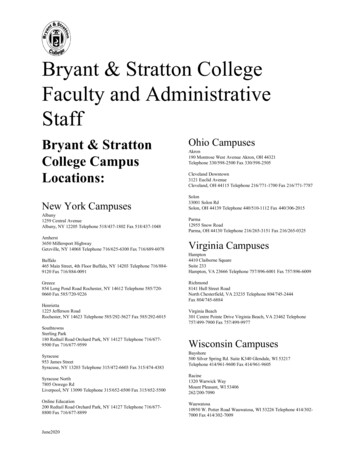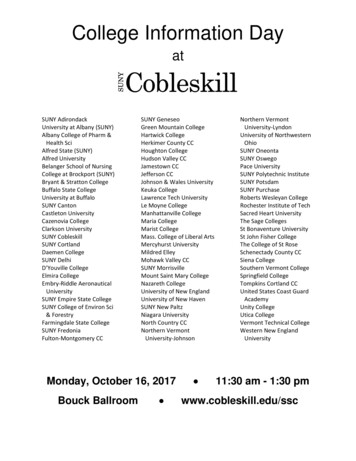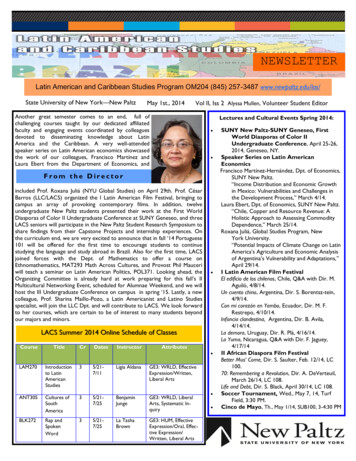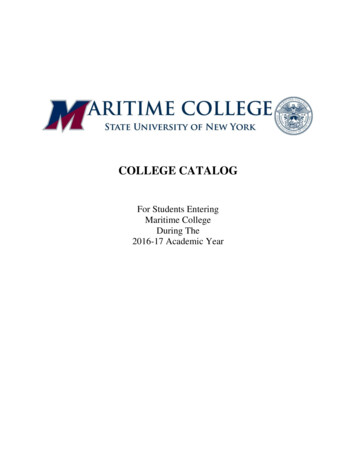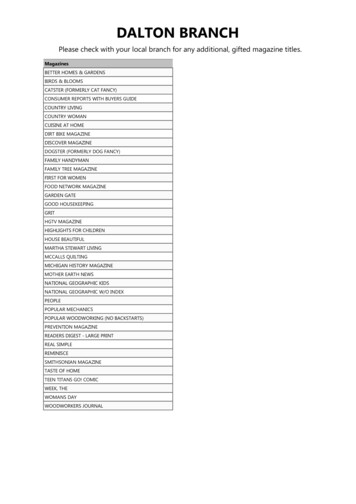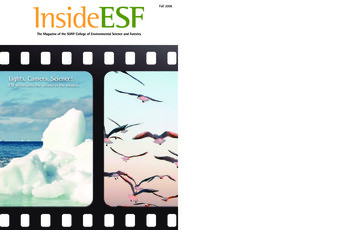
Transcription
InsideESFThe Magazine of the SUNY College of Environmental Science and ForestryLights, Camera, Science!ESF delves into the science in the movies.Fall 2008
ContentsLed by class marshals Daniele Baker,environmental and forest biologymajor, and Christopher Schalk,environmental science major, ESFgraduates process onto the floorof the Carrier Dome during May 11commencement exercises. For morecommencement photos, see page 8.2 Campus Update6 Life’s Detours Don’t Deter HerAn ESF graduate learns lessons from life’schallenges while helping the poor.8 As They Grow,Pollution ShrinksWillow might be the Army’s secret weaponto clean up contaminated soil.New bike racks were installed on the east end of Illick Hall aspart of the campus master plan. The new hanging racks arelocated under an overhang so they keep students’ bikes dryduring inclement weather.12 Celluloid ScienceESF faculty members take on Hollywood byseparating fact from fiction.InsideESFSUNY College of Environmental Science and ForestryCornelius B. Murphy, Jr., PresidentRobert C. French, Vice President forEnrollment Management and Marketing18 A New HouseA new educational institute finds a home in the Masten House.20 CoyotesHigh-tech tools are being usedto gauge the effect of coyoteson the environment.Office of Communications122 Bray aire B. DunnArt DirectorWendy P. OsborneStaff WriterKaren B. MooreProductionVance M. BlackburnOn the cover: Photo illustration by Wendy P. OsborneOffice StaffPeggy OlrichInside ESF is produced by the Office of Communications ofthe State University of New York College of EnvironmentalScience and Forestry.www.esf.eduPrinted on recycled paper.Photo opposite page by John Faranact, photo top by Wendy P. OsborneFall 2008 1
Campus UpdateWalking the WalkGreener pathways and a rain garden greet studentsOnce a Butter Sculpture;Now Fuel in the TankLetters to the EditorNine hundred pounds of butter, sculpted intoa cow jumping over the moon and positioned asa centerpiece attraction at the New York StateFair, ended up fueling ESF’s vehicle fleet.The College, in collaboration with the American Dairy Association and Dairy Council, Inc.,and the Onondaga County Resource RecoveryAgency, made the butter into biodiesel at theon-campus production facility, which routinelymakes biodiesel from used cooking oil obtainedfrom Syracuse University.Graduate student Dan Nicholson said theconversion process took about a week. He saidnine pounds of butter make about a gallon ofbiodiesel, so this year’s 900-pound sculptureyielded some 90 gallons of biodiesel. n‘Most complete and comprehensive’I just received and read, cover to cover, theSpring 2008 edition of Inside ESF. It is the mostcomplete and comprehensive coverage, that Ihave seen, concerning definitions, observations andinterpretations of being “green,” in particular, andenvironmental concerns in general.Robert W. Carpenter, ’54Monson, Mass.‘We expect your support’It seems that daily, we as representatives ofthe “greater forest industry,” have to debunk wildaccusations regarding the use of the most sustainable natural resource on earth — trees. I have justfinished reviewing Inside ESF and imagine mychagrin when I saw on Page 4 that the College ofEnvironmental Science and Forestry recommends“Baby steps to shrink your carbon footprint,”limiting the use of paper bags, paper cups, paperpackaging and paper products.Please consider the “tree-mendous” impactyour words carry when ESF suggests that “27 million trees a year are cut down for paper towels,”and in the same breath endorses wood use forpower generation. Is there a difference here that Iam missing? Do you honestly believe that thesewords won’t in some small way hurt our effortsto make common sense prevail during the current“Green Revolution”?We expect your support on these issues. Thepublic looks to you as leaders in the field of “wiseuse” of natural resources. Please, there are enoughvoices crying out to change things (make them“greener”), who have limited science education intheir backgrounds.David W. NortonSmurfit-Stone Container Corp.Madison, Fla.We invite letters to the editor.* You can email yourcomments to InsideESF@esf.edu or mail them tous at:Inside ESFSUNY-ESF122 Bray Hall1 Forestry DriveSyracuse, N.Y., 13210-2778*Inside ESF reserves the right to edit letters for contentor length.2InsideESFGraduate students Ryan Tappel and Jessica Hatchhelp disassemble the butter sculpture.Overfishing Causes ‘Dire’ Conditions for Baltic CodA study of Stone Age fish unearthed onan island in the Baltic Sea suggests overfishing by humans is causing fish populationsto evolve and driving commercially valuablespecies like cod to the brink of economicextinction.In a report published this summer in theBritish scientific journal, Proceedings of theRoyal Society B, ESF’s Dr. Karin Limburg andher colleagues reported that 4,500-year-oldearstones, known scientifically as otoliths,and vertebrae from Baltic cod found in apre-Viking settlement on the Swedish islandof Gotland indicate the fish harvested byNeolithic fishers were older and larger thanthose hauled in by 21st century trawlers.Limburg, a fisheries ecologist who is thepaper’s lead author, described the status ofthe cod fishery in the Baltic as “dire.”“It’s such an overfished system,” Limburgsaid. “The big concern is that overexploitation is causing the fish to evolve. The findingthat humans can actually cause evolution offish populations, which in turn can drivetheir degradation, is relatively new and isdrawing a lot of attention.“Some fisheries, including that for cod,are now known to cause ‘juvenescence,’ orthe evolution of younger, smaller adult fish.The ecological and economic consequencesboth appear to be negative,” she said.The findings were reported in one of twoscientific journals published by the RoyalSociety, the United Kingdom’s national acad-ESF students are walking to class thisfall via new walkways around the quad,new outdoor stairways, and new —and more environmentally friendly —entrances at Illick and Marshall hallsand Moon Library.The bridge entrance to F. FranklinMoon Library is now surfaced withFlexi-Pave, a 50-percent ratio ofstone and recycled tires mixed witha urethane binder. Underneath theFlexi-Pave is a Warm Zone heatingsystem to eliminate snow and ice inthe winter. Flexi-Pave is porous, so rainand melting snow flow through to theground instead of producing puddlesor runoff. Installation of this systemmeans salt and sand won’t be neededand that will help protect the newlyrefurbished library.“We’re thrilled to think that the snowwill magically melt before our studentsreach the library front door! This shouldhelp keep our newly renovated spacelooking fresh and clean for years tocome,” said Elizabeth Elkins, directorof College libraries.Flexi-Pave and new bicycle storageracks were also installed at Illick andMarshall halls.The southeast corner of Illick Hall isthe location for a new bioretentionbasin made up of soil and plants, wherea third of the rainwater from the roofwill be diverted. The idea, suggested bya class project, is to demonstrate howrunoff can be controlled so stormdrainage systems are not overwhelmedduring heavy rains.“What we’re doing is diverting rainwater from the roof of Illick Hall to thebioretention basin instead of the stormsewers. Plants will use the water, evaporation will return water to the atmosphere, and excess water will be filteredthrough the soil before entering thenatural environment,” explained ESFecological engineer Douglas Daley.The plants include spice bush, chokeberry, Virginia sweetspire, witchhazel,and sweet bay magnolia, which are allvery tolerant of wet soil.Another rainwater diversion projectis being installed as part of the renovation work on Baker Laboratory. Four1,000-gallon storage tanks have beeninstalled in the basement of Baker Labto collect rainwater from the roof. Thewater will be used in the building’scooling towers. nGreat Schools, Great Prices —ESF Ranked 15th NationallyA Word fromthe NWFemy of science. Proceedings B publishes articles about the biological sciences.For the full story, go iccod.htm. nPhoto top by Karen B. Moore, photos at bottom courtesy of Karin LimburgThe National WildlifeFederation (NWF) laudedESF in its Campus Environment 2008 Report Card.The report recognized240 campuses for makingprogress on sustainability.ESF was cited for settingenvironmental goals andfor students taking coursesabout sustainability.The NWF surveyed morethan 1,000 colleges anduniversities about an arrayof topics related to theenvironment.ESF has, for the eighth year in a row, earned a placeamong the top universities in America, as ranked byU.S.News & World Report.In the “Great Schools, Great Prices” category of the 2009edition of America’s Best Colleges, ESF is ranked 15th. Theformula used in that category relates a school’s academicquality to the net cost of attendance for a student whoreceives the average level of need-based financial aid. ESFis the only SUNY institution listed in this category.ESF is listed at 37 among the top 50 public nationaluniversities, and at 83 in the list of best national universities, which includes both public and private institutions.“ESF is very pleased with our recognition in the U.S.News& World Report rankings of national universities,” PresidentCornelius B. Murphy, Jr., said. “We are most proud of ourlisting of 15th in the category of ‘Great Schools, Great Prices.’To be in the company of the University of Virginia, Brown,Emory and the University of North Carolina at Chapel Hillvalidates the work of our faculty and staff and supports thecontributions of our outstanding students.” nPhotos by Wendy P. OsborneFall 2008 3
CampusUpdateCampusUpdate312 Freshmen Join Ranksof ESF StudentsESF welcomed a record freshman class of312 and 173 new transfer students for the2008-09 academic year.The freshman class includes studentsfrom 19 states and sets a record for ESFenrollment from out of state, with 21 percent of the class coming from outside NewYork. The class marks one of the highestpercentages of out-of-state students in the64-campus SUNY system.ESF received a record 1,545 applicationsfor the freshman class and accepted a recordlow 49 percent of those applicants. The College also received 643 applications fortransfer admission and accepted only 41percent of those applicants.The academic quality of the enteringclass has also approached record levels thisfall. Sixty-five percent of ESF’s enteringfreshmen were ranked in the top quartile oftheir high school class, and 25 percent wereranked in the top tenth. The average highschool GPA was just over 90. nESF Faculty, Staff Honored by ChancellorChristopher Nowak, Cheryl S. Doble and John TurbevilleThree ESF employees were honored by InterimChancellor John B. Clark for their service to the StateUniversity of New York.Associate Professor Cheryl S. Doble received theChancellor’s Award for Excellence in Faculty Service. Theaward recognizes the consistently superior service contributions of teaching faculty. Doble, a faculty memberin the Department of Landscape Architecture since 1993,specializes in community planning and design, citizenparticipation, and site planning and design graphics.She established the Center for Community DesignResearch (CCDR) within ESF’s Department of LandscapeArchitecture. The CCDR is an outreach program thatworks in partnership with communities and other4InsideESFacademic programs, to provide technical assistance,educational programs, and research projects that buildcommunity capacity to manage sustainable futures.Dr. Christopher Nowak, associate professor in theDepartment of Forest and Natural Resources Management, was honored with the Chancellor’s Award forExcellence in Teaching. This award honors those whoconsistently have demonstrated superb teaching at theundergraduate, graduate or professional level.Since joining the ESF community in 1998, Nowakhas provided a rigorous professional approach in theclassroom and field, facilitating a positive learningexperience for students and promoting intellectualdialogue. He regularly teaches both undergraduate andgraduate courses in forest science including forestecology and silviculture, Adirondack forest ecologyand dendrology, and forest vegetation management,as well as focused seminars in forest ecology.John Turbeville received the Chancellor’s Award forExcellence in Professional Service. The award recognizesconsistently superior professional achievement withinand beyond the position and those who serve as professional role models for a university system in the pursuitof excellence.Turbeville is coordinator of experiential learning andthe Academic Success Center and has been at ESF since2002. He was a driving force behind the establishmentof ESF’s new Academic Success Center that focuses ontutoring, academic guidance, and mentoring for undergraduate students. nPhoto top by Christopher McCarthy, LA ’11, photos bottom by Claire B. Dunn.ESF Professor Honoredfor Excellence inTeachingDr. Alexander Weir, ESFassociate professor in theDepartment of Environmental and Forest Biology,has been honored by aprofessional organizationfor excellence in teaching.Weir received theAlex Weir receives his award from Mary Berbee, chair ofMycological Society ofthe Mycological Society of America Distinctions Committee.America’s (MSA) William Photo courtesy of the Mycological Society of America H. Weston Jr. Award forExcellence in Teaching. The award is given annually to an outstanding teacher of mycology at the undergraduate and/or graduate levels.In one of the many supporting nomination letters, a formerstudent wrote, “(Weir) is not only passionate about mycology,he is dedicated to his students, he genuinely loves to teach, andhe creates a positively infectious atmosphere toward the studyof fungi and their relationships to ecosystem functioning.”The William H. Weston Jr. Award for Excellence in Teachingis named for the first president of the MSA, who was an inspirational teacher at Harvard University.Another ESF faculty member, Dr. Chun Wang, won the awardin 1990, making ESF one of only two colleges to have had morethan one faculty member so recognized in the past 20 years.Weir teaches mycology and diversity of plants. He is alsodirector of ESF’s Cranberry Lake Biological Station in theAdirondacks. nStudent ReceivesAcademic HonorDaniele Baker of Hollidaysburg, Pa., was honored with theSUNY Chancellor’s Award forStudent Excellence during anApril ceremony in Albany, N.Y.Baker received a Bachelor ofScience degree in environmentalbiology from ESF at its commencement ceremony in May.Baker was presented with heraward during a ceremony at the Empire State Convention Center,where she received a framed certificate and a medallion, which wasworn at commencement.Chancellor Award honorees excel both in academic achievementand in at least one of the following areas: leadership, athletics, community service, creative and performing arts, or career achievement.Baker was the student representative to the ESF Board ofTrustees, an orientation leader and mentor, and a member of theBaobob Society. She also worked on multiple research projects. nPhotos by Wendy P. OsborneNew Faces at ESFESF Names New Deanof Student Life andExperiential LearningDr. Cynthia Sedgwick has beenappointed dean of student life andexperiential learning at ESF.Sedgwick holds a Ph.D. in highereducation administration from theUniversity of Virginia as well as amaster of arts degree in human resources management fromGeorge Mason University and a bachelor of arts degree in psychology from Hampton University.Sedgwick comes to ESF from SUNY Binghamton, where shewas associate dean for assessment and special programs in theDivision of Student Affairs. Previously, she served as associatedean for academic affairs and administration in the WatsonSchool of Engineering and Applied Science at Binghamton andas director of Career Services at the University of Connecticut.Sedgwick began her new position July 1.ESF Names New Directorof Information TechnologyYuming Tung was appointedESF’s new director of informationtechnology.Tung comes to ESF from Syracuse University, where he washead of Library Information Technology Services. Prior to joiningSU in 1999, he held positions asmanager of network and systems at LeMoyne College and as senior programmer/analyst at SUNY Upstate Medical University.Tung holds a master of science degree in computer systemsand information science and a master of library science in libraryand information science, both from Syracuse University, as wellas a bachelor of science in mechanical engineering from ShanghaiCollege of Mechanical and Electrical Engineering.Tung began his new position June 2.Governor Appoints New Trustees to ESF BoardGov. David Paterson appointed three new members to ESF’sboard of trustees.Matthew J. Marko, Vita DeMarchi, and Thomas C. Buckel Jr.have joined the volunteer 15-member board which providesdevelopment, support and oversight of the College.Marko, of Syracuse, is senior project manager with Denverbased CH2M Hill. DeMarchi, of Manlius, is president and chiefexecutive officer of Synapse Risk Management, LLC. Buckel, ofSyracuse, is a partner with Hancock & Estabrook, LLP.Jorge Barbosa, a senior environmental and forest biologymajor, will serve as the student representative to the board.Fall 2008 5
a“Life is full of ups and downs, and Ichallenge myself every day to acceptthe good of life and preserve andcherish it, but also the not-so-good,as a way to learn a lesson andmove on in the right direction.”Commencement 2008Life’s DetoursDon’t Deter Herby Claire B. DunnAfter Ana Maria Menezes’ country overruledher plans for a law career, ESF helped herfind another way to help the poor.As Ana Maria Menezes envisioned the life she was workingtoward, it included some specific scenes: Be a lawyer. Get aPh.D. from Duke or Berkeley. Work for the World Bank.Reality, however, did not play out that way. The educationalauthorities in her native Mozambique said, “No!” to a legalcareer and shunted her into science. The Fulbright scholarshipprogram said, “No!” to Duke and the University of California atBerkeley and directed her to a small school in Central NewYork, previously unheard-of by her. And days before she headedto Washington, D.C., to begin a consultancy with the WorldBank, her prospective employer said, “No!” and explained thatnepotism rules meant she could not be hired because she had arelative who worked there.But Menezes remained undeterred. She had learned to see abumpy journey in life as a way to search for a dream.In May, she crossed the stage at the Landmark Theatrein downtown Syracuse, Ph.D. in hand, on the next step of aprofessional journey that began in a poor country in southeastern Africa. Her desire to be a lawyer started there, whenshe was a 12-year-old student in a re-education camp whereshe and some schoolmates were sent because they were considered troublemakers.6InsideESFCommencement photos by John Faranact, photo top by Wendy P. OsborneHer current stop is Washington, D.C.,and a position with the United Nations’Food and Agricultural Organization,where she is searching for solutions to apotential global fish crisis.“I learned how to look at the past in apositive way and learned what couldAna Mariahave been done better,” she said a fewdays after receiving her doctorate inenvironmental and natural resources policy from ESF. “Life is full of upsand downs, and I challenge myself every day to accept the good of lifeand preserve and cherish it, but also the not-so-good, as a way to learn alesson and move on in the right direction.”At the request of the FAO, Menezes is doing work that grew out ofher doctoral dissertation: studying the connection between naturalresource policies and poverty-reduction strategies in developing countries. She will focus on artisanal fisheries.“People’s lives depend on artisanal fisheries. They have very littlechance to develop and to look for opportunities beyond their communities. All this is related to poverty,” she said. “In our country, less than 0.5percent of the artisanal fishers have a motorboat to go fishing. They goin a sailboat, or a small boat they power themselves. Some of them liveon less than 50 cents a day.”The questions, she said, are these: At what point are the national andlocal policies converging to reduce poverty? And are the policies beingimplemented properly?Menezes will also contribute to the FAO database, providing information about small-scale and commercial fisheries in Mozambique and otherAfrican nations, looking at factors that include employment, food fishproduction, fuel consumption and fish caught per ton of fuel. She willwork in collaboration with the World Bank’s PROFISH program, which aimsto promote effective fisheries strategies and policies both locally andglobally, and the WorldFish Center, which works internationally toresearch and improve small-scale fisheries and aquaculture.Menezes laughs now when she thinks about her initial reaction to theFulbright program’s interest in having her enroll at ESF. Fulbright officialscaught her off guard, contacting her after previously rejecting her application. Menezes wasn’t sure she wanted to do it. She was past her 40thbirthday and was reluctant to undertake the rigors of a Ph.D. program.“I said, ‘I’m not going to apply. I don’t want to do it.’ Then: ‘Well,when is the interview?’ They said, ‘Tomorrow.’”She went to the interview and insists it was the worst such meetingof her life.“I mixed English, Spanish, French, somePortuguese, you name it,” she said, leavingout only Italian, her fifth language.This time, the Fulbright program offeredher a scholarship. Menezes immediately sether sights on Duke or Berkeley. But the Fulbright program wanted her to come to ESF.A conversation with Dr. Richard Smardon,professor in ESF’s Department of Environmental Studies, convinced her ESF wasthe right choice. She intermingled herenvironmental policy studies with classesat the Maxwell School of Citizenshipand Public Affairs at neighboringMenezesSyracuse University.“Ana is unique, and I don’t think wehave seen many Ph.D. students like her,” Smardon said.“Ana has an inner sense of what is fair and what is not and will standup to anybody if she thinks someone has crossed the line. Some facultyand students alike have experienced this firsthand,” Smardon added.“She has a great sense of community and works tirelessly for the sake ofcommunity-building, whether it be cooking and arranging a social eventor mediating/initiating dialogue or developing new qualitative researchdesigns to access her research subjects back in Africa.”Growing up in Mozambique, emerging from childhood in the mid1970s, just as her country gained independence, Menezes dreamed ofbeing a lawyer. She had seen injustice firsthand at the re-educationcamp and she wanted to pursue a profession in which she could speakout for those whose voices are not heard.Her country had other ideas.“Unfortunately, when time to go to college came, the administratorsof educational services decided that I did not have the political fiber andpolitical vision they thought necessary to study law,” said Menezes. “Fortheir political prejudice, I was forced to enroll in the School of Agricultural Engineering.”Menezes found a niche helping communities by promoting ruraldevelopment and social justice.“It was not really my passion when I began my career. But I found Icould help represent these people by teaching them the best way to usetheir natural resources,” she said.Menezes researched the application of shrimp culture in Mozambiqueand led the nation’s Aquaculture Department. She pursued a master’sdegree at Auburn University, focusing on the effects of agricultural pesticides on marine life and intensive production systems for African tilapiaand catfish.She decided that teaching about resource management policy can bejust as beneficial to the underprivileged as a legal career.“I came to understand I could promote equity and economic andsocial justice by giving the power of what knowledge I have to ruralcommunities by teaching them their rights,the best practices of natural resource management and the power of collectiveaction,” she said. “I ended up in a fieldwhere I can have it all, where I still canpromote justice, continuously learn andteach such values. And not just be — butbecome something more.”Ana Maria Menezes participates in thecommencement weekend activities withESF faculty member Jack Manno andCollege President Cornelius B. Murphy, Jr.Photo by John FaranactFall 2008 7
AS THEYGROW,POLLUTIONSHRINKSStory and photos by Claire B. DunnFifty years of fuel leaks.Twenty-three thousand willows.Eight million dollars saved.“It doesn’t get any better than this,”says ESF’s Dr. Christopher Nowak.Nowak makes the statement as he weaves his way througha stand of graceful willows at the Army installation at Fort Drum,80 miles north of the ESF campus. It’s a blue-skied early summermorning, and the willows’ delicate leaves are backlit by a brilliantsun. The plants are healthy and growing fast, as willows areinclined to do.As they soak up the sun’s energy, they are also busy suckingcontaminants out of the ground, helping to clean up a 164,000gallon plume of fuel that has been spreading underneath theexpansive North Country military base since World War II.Nowak believes it’s the largest phytoremediation effort —the process of using plants to remediate contaminated soils andgroundwater — in North America.“The phytoremediation is actually the last step, the polishingof the system,” said Nowak, a professor in ESF’s Department ofForest and Natural Resources Management. “We’ve worked outhere for seven years.”The willows are part of an aggressive cleanup strategy toremediate groundwater contamination caused by fuel that leakedfrom the tank farm along Fort Drum’s “Gasoline Alley.” The military installation, home to the Army’s 10th Mountain Division —8InsideESFDonald J. Beevers, left, and ESF’s Dr. Christopher Nowak survey thewillows that are helping to clean up the groundwater at Fort Drum.Light Infantry, covers more than 107,000 acres. This year, thebase is marking its 100th year as a military training site.No one knows exactly when the leaks began — perhaps asearly as World War II — but they were discovered in 1988, whenthe petroleum, which had been spreading in an undergroundplume for many years, began to foul small creeks on the base.The plume has been flowing downhill under the Old SanitaryLandfill, which closed in the mid-1970s. It moved through thesandy soil left behind by the ancient Lake Iroquois, the forerunner of Lake Ontario, and showed up in groundwater thatsurfaced as creeks in low-lying areas. The creeks were turningrusty brown with precipitated iron and bacteria as the petroleumsurfaced in “seeps” that brought groundwater to the surface.Donald J. Beevers, the installation restoration project manager,who is employed with contractor Applied Services & InformationSystems at Fort Drum, said roughly 1 million has been spenton the remediation project. He estimated that constructing atreatment plant would have cost more than 8 million.The goal is to develop a phytoremediation model that can betailored for use at similar sites across the United States.“We want to transfer the technology,” Beevers said. “Thisisn’t the only Department of Defense landfill.”Said Nowak: “This is just one military base of many, and itwas clear that what we are doing here could be applied elsewhere. It’s tailored phytoremediation.”Nowak and his colleagues began with a small pilot plot,which expanded over the years to 2 acres. He has experimentedwith some 30 varieties of willow trees and shrubs to see whichones grow best.Fall 2008 9
As a silviculturist, Nowak’s specialty is the care and tending of treecommunities. Part of the challenge in this case was finding a way forthe willows to grow in the contaminated soil. He settled on plantingboxes, bottomless wooden frames filled with soil that containedenough nutrients for the young plants to establish themselves beforethe roots reached soil that was soggy with petroleum-laced water.It was a laborious task. His students lugged in enough soil to fillthe original 60 planting boxes. The expanded system has nearly 900planting boxes that were filled by contractors using a speciallydesigned machine to pump soil across the site.Now the landscape is dotted with monitoring wells and piezometersthat track the level of the water table.ESF is one of many partners in the project, which also involvesinstalling a new cap on the old landfill.Nowak said the willows are a cost-effective, environmentallyfriendly way to treat the contamination.You never knowwhen you’llstumble acrossa stumpie“Look, we’re getting sedges and cattail in here.They came for free and are contributing to thephytoremediation,” said Chris Nowak.“Photosynthesis drives the system. It’s a sun-driven system withtranspiration of water as the key,” he said. “Ecological engineeringprojects like this relinquish control to nature. Look, we’re gettingsedges and cattail in here. They came for free and are contributingto the phytoremediation.”There are also asters, goldenrod and several grasses thriving amongthe willows. Protected by fencing from foraging deer, the willows areleafy and densely planted. The biggest ones absorb five gallons ofwater per day. At the quarter-acre site of the pilot project 5,000 to10,000 gallons of water per day are pumped from the site by the willows. Without the willows, that water would flow into the creek.The willows do their work naturally. Uptake of water lowers thewater table and allows roots to grow. Root systems create a habitatthat invites the presence of bacteria and fungi that break downcontaminants; the plant uses some of th
Emory and the University of North Carolina at Chapel Hill . Monson, Mass. ‘We expect your support’ . Another ESF faculty member, Dr. Chun Wang, won the award in 1990, making
